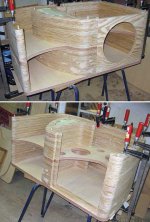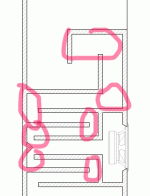Wherever you like, although for aesthetic reasons I wouldn't put them so low as to be visible through the lower horn, or so high as to leave your wire dangling about in mid-air. You can route out a channel & glue it in place if you want, me, I'd just make sure it's not flapping about & you should be fine.
bass needs to improve in quality. Hard to describe this in words. Needs to lose a bit of boom and gain a little speed perhaps?
Fran
This is my issue right now, I'll be playing around with more damping tonight. I've got a good 600hours on the FE207s/sachikos now, and now that I have all the right gear running (including the planet10 plugs), it's FINALLY time to start fine-tuning the bass. SO I'll start adding to the compression chamber a bit more.
I'm also happy to hear this cleans up the highs a bit. It makes sense, since the less garbage that leaks out the horns, the clearer the treble will be.
PS - these speakers kick **** already.
I used scottmoooses advice.
Try lining one wall of the chamber. Refit the drivers and listen again. Then do another wall etc etc. You will hit a sweet spot at one point. I ended up with 1/2" wool felt lining the back top bottom and side walls of the chamber and the bass is satisfying. Not subwoofer low, but you wouldn't really miss it on most music unless you listen to a lot of stuff with low synth bass lines (and then you wouldn;t really be into horns then!!)
Keep us posted on how you're getting on...
Fran
Try lining one wall of the chamber. Refit the drivers and listen again. Then do another wall etc etc. You will hit a sweet spot at one point. I ended up with 1/2" wool felt lining the back top bottom and side walls of the chamber and the bass is satisfying. Not subwoofer low, but you wouldn't really miss it on most music unless you listen to a lot of stuff with low synth bass lines (and then you wouldn;t really be into horns then!!)
Keep us posted on how you're getting on...
Fran
a horn starts off small and gets larger in diameter as the sound escapes. all the designs of horn speakers for DIY that I see, start small and get larger in only 2 of the 3 dimensions - not width. the width stays the same as the cabinet. why dont the designs expand in all 3 dimensions?
For any of a number of reasons. They're harder to build for most people (anything from difficult to a downright nightmare), and you have to keep in mind that back-horns are by nature a compromise. In many respects they are more akin to a bass-reflex enclosure than a horn proper; they operate over a narrow BW, so providing your acoustic XO is set below the frequency at which a horizontal standing wave might develop between the parallel walls, then they're not necessarily going to be one of the major concerns. Of course, this tends to mandate a relatively slim enclosure if you want to minimise the risk of such things occuring, which brings with it its own compromises (aspect ratio; terminus size etc), but that's another matter.
Last edited:
thank you. so its pragmatic to not worry about it.
I am interested in building a full range single driver speaker. I have a SET amp and am after high efficiency flat response over the entire range. I was going to with the Fostex 206e, but am open.
with cnc cutting, it should be easy to cut smooth horn shapes in all three dimensions, starting narrow at the driver and expanding either the width or keeping the width the same but only letting the path of the sound travel through some of that width to start... I need a pic here (or a greater patience with the written word).
how do I get the design into a file that the cnc machine can cut from?
thanks
I am interested in building a full range single driver speaker. I have a SET amp and am after high efficiency flat response over the entire range. I was going to with the Fostex 206e, but am open.
with cnc cutting, it should be easy to cut smooth horn shapes in all three dimensions, starting narrow at the driver and expanding either the width or keeping the width the same but only letting the path of the sound travel through some of that width to start... I need a pic here (or a greater patience with the written word).
how do I get the design into a file that the cnc machine can cut from?
thanks
thank you. so its pragmatic to not worry about it.
Assuming a half-decent design, it's a non-issue on some fronts, and on the others it pales into insignificance compared to such things as the effects of compromising the size of the horn itself, which have much more drastic consequences. So yes, you could call that pragmatic.
I am interested in building a full range single driver speaker. I have a SET amp and am after high efficiency flat response over the entire range. I was going to with the Fostex 206e, but am open.
Reasonable choice.
with cnc cutting, it should be easy to cut smooth horn shapes in all three dimensions, starting narrow at the driver and expanding either the width or keeping the width the same but only letting the path of the sound travel through some of that width to start... I need a pic here (or a greater patience with the written word).
That would give maximum efficiency for whatever your general dimensions are to be sure. I assume you've taken into consideration that you might not actually want that though? One of the drawbacks of perfectly smooth flares (for back-horns) is that they allow more unwanted midrange leakage through the horn, screwing up the imaging & causing problems in the time domain (group delay becomes more audible with ascending frequency). A back-horn is not the same thing as a (front) horn. Different criteria / requirements come into play.
how do I get the design into a file that the cnc machine can cut from?
'How long is a piece of string' would be the short answer. Depends on the machine. dxf files are often used I believe, but the easiest solution would be to ask your chosen wood-shop what format they accept files in.
ok so I need to put my mind to rest and not worry about a folded horn in 3 dimensions. is it better to use a box type construction? or slice like this New GOTO Bass Horn underway
my amp is sb343971 - Time Machine 45 / 2A3
is the fostex206e the best choice?
thanks
my amp is sb343971 - Time Machine 45 / 2A3
is the fostex206e the best choice?
thanks
No such thing as a universal 'best' choice but the 206 is a very good driver of this type & should meet your requirements. Same applies to box construction types, 3d expansion etc.
Don't get me wrong here; 3d expansion can work well. What you have to do is consider the tradeoffs (for & against) & decide whether you think the extra effort is worth the potential advantages. Similar situation with translam construction. It depends on what you are hoping to achieve. Everything is a compromise. You pick the ones you can live with.
Don't get me wrong here; 3d expansion can work well. What you have to do is consider the tradeoffs (for & against) & decide whether you think the extra effort is worth the potential advantages. Similar situation with translam construction. It depends on what you are hoping to achieve. Everything is a compromise. You pick the ones you can live with.
ok so I need to put my mind to rest and not worry about a folded horn in 3 dimensions. is it better to use a box type construction? or slice like this New GOTO Bass Horn underway
Note that that is not a horn at all. It is a bass reflex with a Big Vent.
dave
so I wasn't sure what it looked like / was.
Pretty as Andrew's stuff usually is, but i decry the significant waste of material (and, my feeling, not the best application of the panel's natural properties) to execute these kinds of designs. Certainly not "green")
dave
Attachments
Not in my opinion. And it is no more accurate than a CNC panel saw (or a table saw with an on the ball operator.
Its prime purpose is to apply brute force to get swoopy shaped cabinets.
It is useful if you need an unusual shape and allows some things that might be harder to do other ways, but what you give up to get there is most often not worthwhile.
I don't know how many enquiries we have fielded on doing translam Olson-style horns with smoothed corners.... a good way to ruin the performance.
dave
Its prime purpose is to apply brute force to get swoopy shaped cabinets.
It is useful if you need an unusual shape and allows some things that might be harder to do other ways, but what you give up to get there is most often not worthwhile.
I don't know how many enquiries we have fielded on doing translam Olson-style horns with smoothed corners.... a good way to ruin the performance.
dave
ok - thanks - I just assumed that the folded horn was trying to take a smooth shape and bend it to save space.
so I thought it was logical that smooth internals would be superior to angular shapes inside.
I also assumed that before cnc, it was easier to build a series of straight lines than curves.
in reference to my accuracy comment - it wasnt restricted to the cutting - I also meant that the dowels kept the slices spot-on during construction - where the traditional method allowed the DIY'er to allow small movements.
I just want a nice speaker and initially thought sachiko after some googling, and then thought it too hard and settled on dallas III
newbie Wat44
so I thought it was logical that smooth internals would be superior to angular shapes inside.
I also assumed that before cnc, it was easier to build a series of straight lines than curves.
in reference to my accuracy comment - it wasnt restricted to the cutting - I also meant that the dowels kept the slices spot-on during construction - where the traditional method allowed the DIY'er to allow small movements.
I just want a nice speaker and initially thought sachiko after some googling, and then thought it too hard and settled on dallas III
newbie Wat44
i had thought that was taking place before the mouth with all of the right angles of the expansion chambers before the mouth chamber. anyone hear both options and how much do they really help compared to the sloped option?In sachiko the steps serve a purpose -- the expansion at every fold is a low pass filter which remives HF energy from getting out of the mouth.
dave
secondly, if it is needed and the slant wall was already installed or if one would like to cut down on overall weight, anything detrimental in constructing the stepped inner more like a staircase without each step spanning the full depth of the cabinet to the back wall?
- Status
- This old topic is closed. If you want to reopen this topic, contact a moderator using the "Report Post" button.
- Home
- Loudspeakers
- Full Range
- Sachiko Build Thread!

